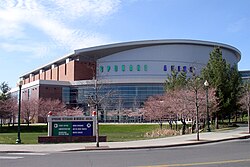Basketball
Spokane Arena, in addition to its duties as being the host of Chiefs and Shock games, also has served as a secondary home for the men's basketball programs of Gonzaga University and Washington State University for nearly every year since opened. Washington State has played 33 matchups in the Spokane Arena in 19 of the 22 years with a record of 18–15 (1–7 vs. ranked opponents), while Gonzaga has hosted 18 games in 15 of the 22 years with a record of 12–6 (1–2 vs. ranked opposition). In-state rivals Washington State and Gonzaga have faced off against each other in the arena on five occasions (1995, 1996, 1998, 1999, and 2014) with the Zags owning a 3–2 record against the Cougars in those games. The Bulldogs' faced off against local rival Eastern Washington University at the arena in four consecutive years (2002, 2003, 2004, and 2005), each won by the Zags, but just like with the Cougars, the rivalry has gone dormant due to the rise of the Zags' program to major status since the late 1990s, while the Cougars and Eagles have not seen much national spotlight. Washington State has often hosted home games at the Spokane Arena as a part of its Pac-12 Conference men's basketball schedule, holding a 7–9 against conference foes in the arena, facing UCLA (1996 and 2004), Oregon (1997 and 2011), Oregon State (1997, 2011, and 2017), Arizona (1998, 2001, and 2006), Washington (1999), USC (2000 and 2004), Stanford (2004), California (2005), and Colorado (2014). With Gonzaga's rise to prominence, the Zags were able to bring high major schools like Washington (1998), Georgia (2003), Memphis (2007, 2009, and 2011) and Oklahoma (2009) to the Spokane Arena, with the Gonzaga holding a 2–3 record in those matchups, but with conference realignment and the West Coast Conference's additions of BYU (2011) and Pacific (2013), the Zags have been more selective and limited in their scheduling with four less matchups in their non-conference schedule, so they have only played in the Spokane Arena once since 2012. [8] [9]
It also hosted the WIAA Class B state high school basketball tournament annually until 2006. The tournament came back to the arena in 2007, but as the Class 2B tournament. The WIAA had split the B classification into 1B and 2B. The Yakima SunDome in Yakima hosts the 1B tournament. The Class 1B tournament returned in 2011 when the WIAA changed the state tournament format.
Notably, this was the reason why the West Coast Conference men's basketball tournament had never been in Spokane before 2006; the Class B and WCC tournaments clash every year, and Gonzaga's on-campus arena at that time, the 4,000-seat Charlotte Y. Martin Centre, was too small to host the WCC tournament. In 2004, Gonzaga opened its new on-campus arena, the McCarthey Athletic Center, which enabled it to enter the rotation; the WCC tournament moved to the neutral Orleans Arena in Las Vegas in 2009.
NCAA Division I tournaments
Spokane Arena has been the site of several NCAA Division I basketball tournament games (men and women), with Washington State University as the designated host school. For the men, the arena hosted in the opening rounds in 2003, 2007, 2010, 2014, 2016, and 2024, the latter two of which were hosted by the University of Idaho for the first time. Prior to the arena's opening, the NCAA tournament was held in the region on the WSU campus in Pullman at Beasley Coliseum (1975, 1982, 1984).
The arena was a women's regional site in 2008, 2011, 2015, 2018, 2022 and 2025. The 2011 regional was notable as Gonzaga became the lowest-seeded team ever to make a regional final in the women's tournament. [10]
In January 2007, the Spokane Arena was one of two facilities to host the 2007 U.S. Figure Skating Championships (the other being the Group Health Exhibit Hall at the Spokane Center several blocks away.) The arena, as well as the city, received many rave reviews and also shattered the previous attendance record for the event, previously held by Los Angeles, California, by over 30,000 attendees.
On May 5, 2008, it was announced that Spokane would once again host the U.S. Figure Skating Championships leading up to the 2010 Winter Olympics. Spokane Arena was the sole venue for the 2010 U.S. Figure Skating Championships. Held January 15–24, it broke its own attendance record with 158,170 tickets sold during the ten-day event.
Also, the Spokane Arena hosted the very first 2016 Team Challenge Cup, where athletes from North America, Europe, and Asia, competed against each other in teams. Team North America won the event.





